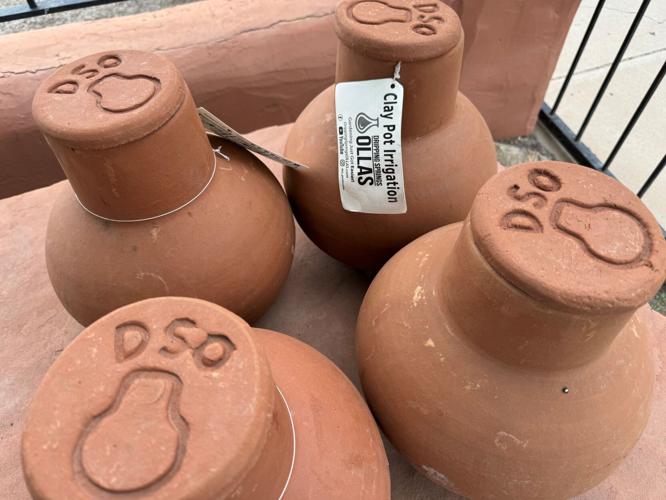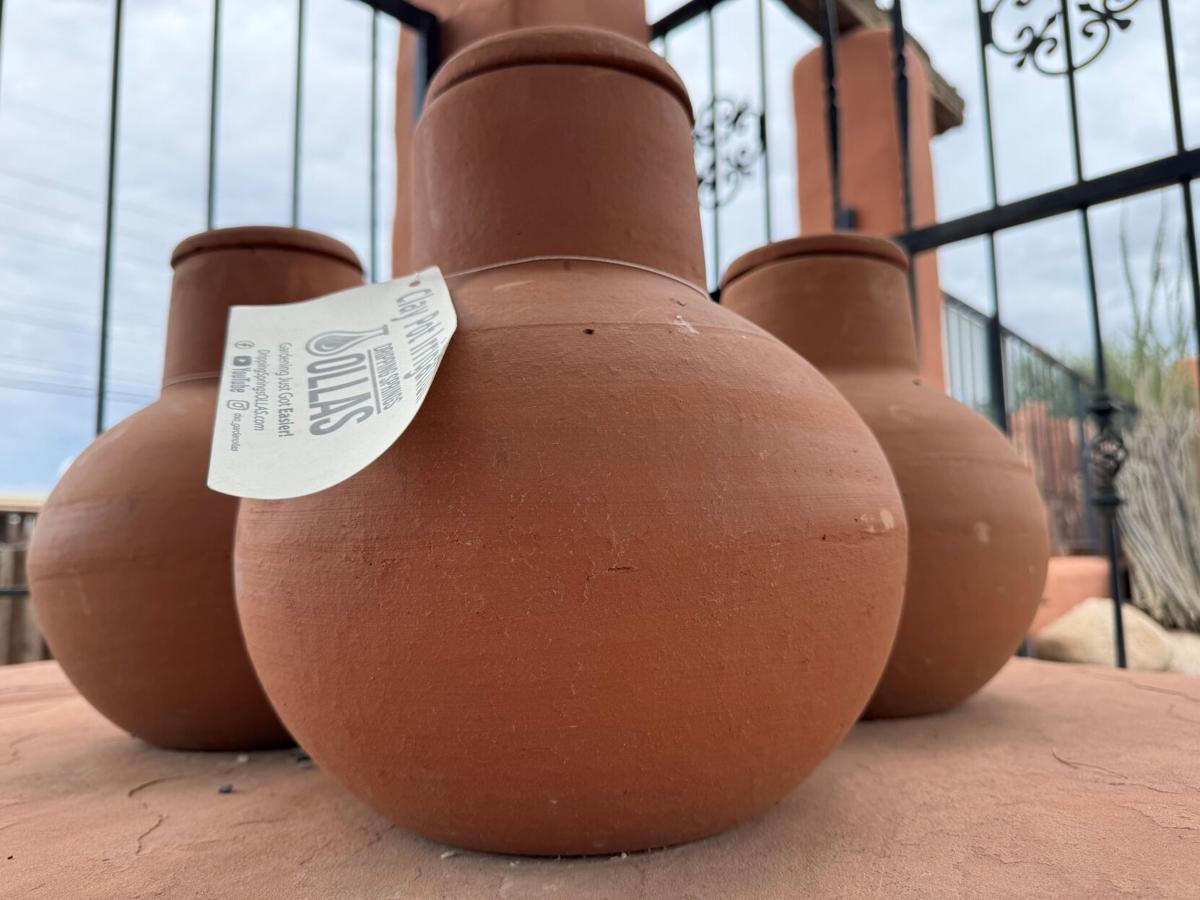Did you know that a 4,000-year-old technology can help you grow plants and conserve water in your garden? You may have heard of ollas, which are vessels made of unglazed clay fired at low temperatures (terracotta); these are then buried in the soil near plants and filled periodically with water.
This watering technique is thought to have originated in North Africa and China at least 4,000 years ago, and has since then spread through other arid lands. It was likely also independently discovered in the pre-Columbian Americas.
Ollas are an excellent tool for the dryland gardener. They work particularly well in larger containers such as garden beds. They are great for growing food crops that have a lot of deep roots, like squashes, melons, cucumbers, tomatoes, chilies and similar crops.
They can also help you get young native trees and shrubs established, and can help you grow some shrubby ornamentals, as well.
How ollas work
Ollas can be any unglazed covered clay container, even the terracotta ones you can get from your nursery (or IKEA). The “unglazed” part is critical, because it means the clay pot is porous to water. You bury the pot in your soil up to its neck, fill it with water, and over time the water spreads from the pot to the surrounding soil via capillary action through the tiny pores in the clay. The drier the soil is, the more water moves out from the pot and into the soil. If the soil is wet (say after a rainfall) then the water in the pot just stays where it is. This simple technology means that your plant roots only get water when they need it.
The “covered” part is also critical, because the water reservoir must be covered to prevent evaporation, keep out insects, lizards and other small critters, and keep mosquitoes from breeding. It also keeps out soil and other debris.
Ollas are perfect for crops or ornamental plants that need regular water and have fibrous root systems that go down a foot or two in the soil. They work less well for smaller plants because in our climate the soil surface dries out quickly. They also don’t work too well if you’re germinating seeds in place — for instance if you’ve sown carrots or beets into a container. In those cases, you will need to wet the soil surface regularly to ensure germination and growth while the plants are small. However, with recommended crops (like squashes, for example) you can plant your seeds right next to the olla wall so that they will get plenty of water while they’re young.
Pairing ollas with a thick layer organic mulch will help soils stay moist in our dry climate. If you want more of a reservoir, you can also link together several ollas in series using irrigation tubing.

Ollas usually come with lids to keep mosquitoes, other critters and soil from getting into the water reservoir. They are made from terracotta clay, which is porous to water.
Plants that benefit from ollas
Crops such as squashes, melons, cucumbers, tomatoes, chilies and other crops with fibrous roots are well-suited to using ollas.
Small native shrubs, perennial grasses, larger flowering perennials like globemallows, roses, dahlias and similar plants can also do well with olla irrigation, although plants that are not drought-tolerant may need additional watering systems.
Young trees and larger shrubs that are getting established can also benefit, particularly if they are native to this region. Keep in mind that eventually their roots may crack the ollas, but native plants will likely have outgrown their need for extra water by the time this happens.
Pros of ollas
- They are very efficient at providing plants with just the right amount of moisture; you will never overwater or underwater with ollas.
- They can be inexpensive, particularly if you make your own with cheap unglazed clay plant pots and saucers.
- They come in a variety of sizes.
- They don’t require frequent top ups if it’s cool, raining or if the ollas are large, making them good candidates for supplemental watering of native plants on the edges of a garden or property.
- They are all-natural and nontoxic.
- They help gardeners conserve water.
- You will have fewer weeds because the water is being delivered directly to roots.
Cons of ollas
- They take up a lot of soil space, which can be a challenge in smaller gardens.
- Over time, the minerals in city and well water can plug up the micropores. If you collect rainwater, you should use this to fill your ollas.
- You need to plan in advance; it’s harder to put in ollas after you have already planted.
- They are breakable, so you need to be careful with garden tools near ollas. Mark them with a flag if they’re buried in the ground.
- They make your containers heavier.
- They don’t work too well with plants that have small root systems or plants such as larger trees with aggressive big roots which can break the ollas.
- In cold climates, they can crack if the soil freezes. This is unlikely in our area unless you live in the mountains.
DIY ollas from clay planters
Ideally, get a pot that has not been fired at a high temperature as this will prevent water from seeping as efficiently as it needs to. Choose a pot or several, depending on the size of olla you want. You can use a single pot with a saucer lid over it or you can glue two pots together if you want a deeper olla.
1. Plug the bottom hole with a rubber stopper or some food-grade silicone glue.
2. Dig an olla-sized hole in your soil.
3. Insert the olla into your soil and fill with water. Cover with a saucer and refill as needed.
4. If you’re making an olla out of two pots, plug the bottom of one of the pots and then glue them together at the rims with silicone glue and wait for it to dry. Test it for leaks. The olla can be filled through the hole in the second pot.
Here are some helpful videos on making ollas:
- Irrigate like it’s 2000 BC with these easy DIY terracotta watering pots called ollas
- Make your own ollas
Where to get pre-made ollas in Tucson
If you don’t want to fuss with making your own, and you don’t mind spending a bit of cash, here are some local places to get ollas.
- Acme Sand & Gravel has two olla sizes available: quart ($19) and 2.9 gallons ($37).
- Thrive and Grow Gardens also sells ollas along with an optional irrigation system to water your soil surface. A 2-gallon hand-fill olla is $45 or spend $60 for an autofill.
- Olla balls and hookups to irrigation systems from Cutting Edge Ceramics. These can also be purchased at EcoGro. Prices vary depending on the product and the number you order.
- The online company GrowOya also sells different sized ollas (holding 1 to 6.5 liters or 0.26 to 1.7 gallons). These sell for between $31 and $58.
Other olla resources
- “How to use olla irrigation” from Water Use It Wisely
- “Irrigating with ollas” from the University of Arizona Extension
Photos from when more than a half-foot of rain fell in the Tucson area during a five-day span in early October 1983.






